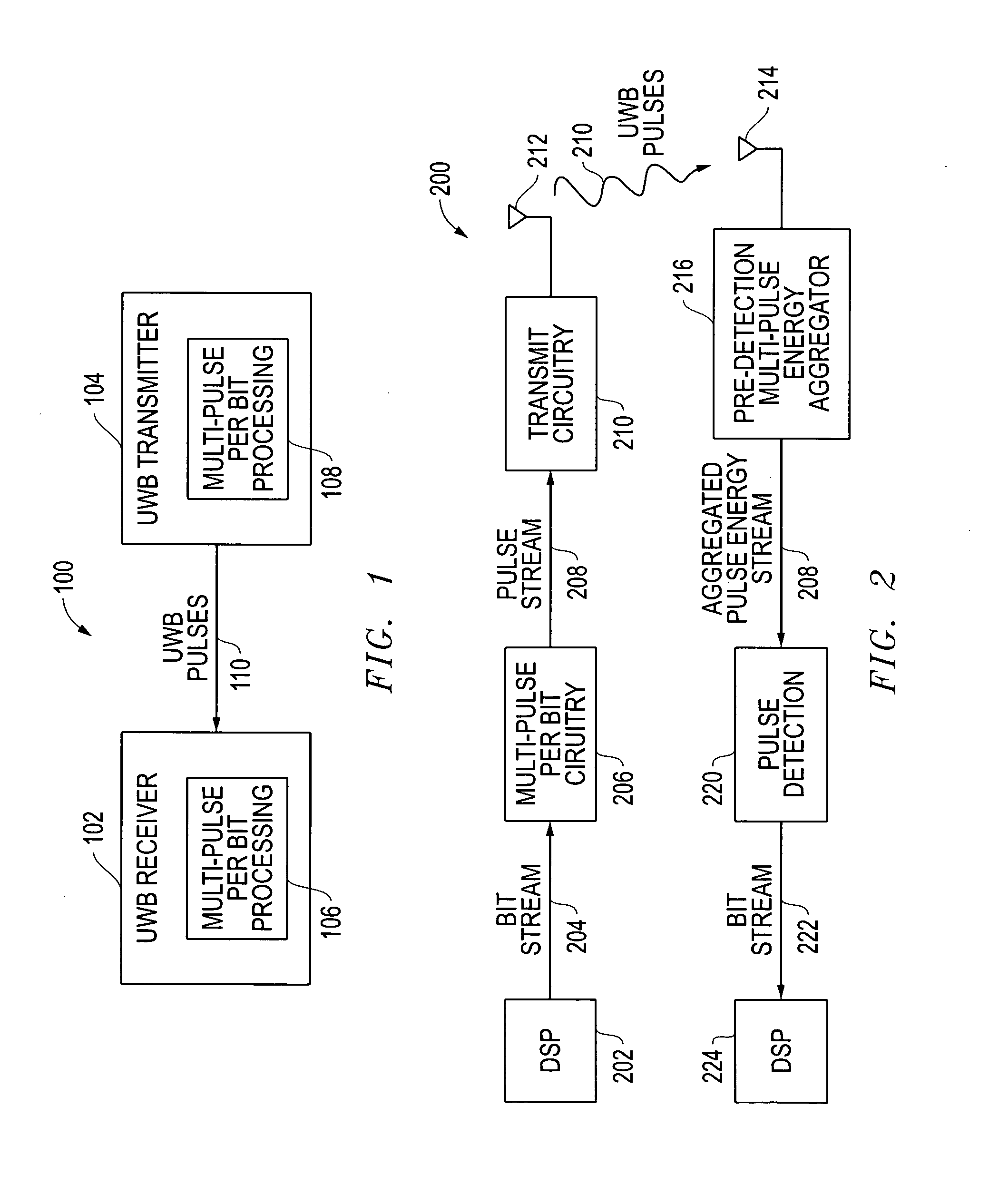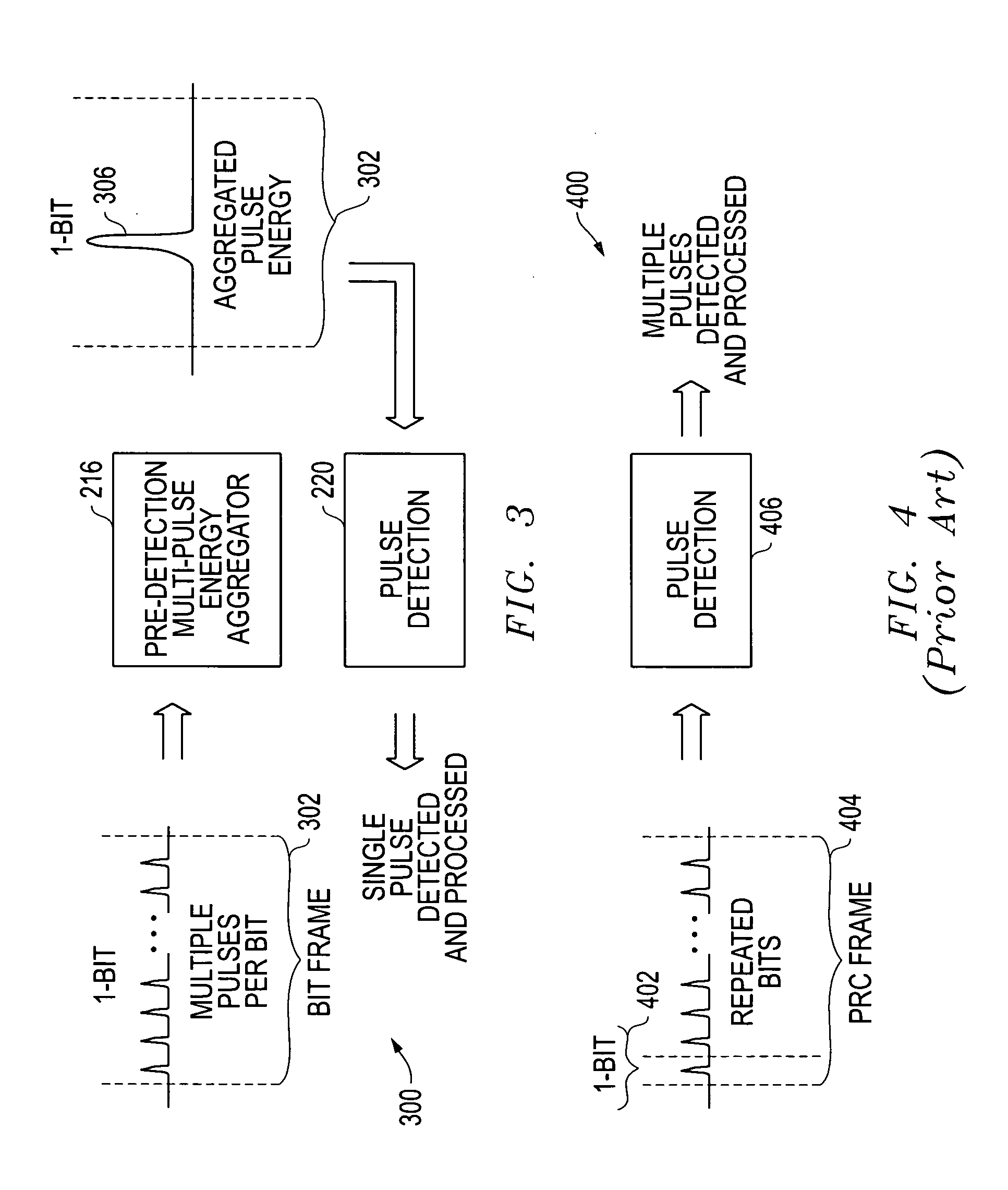Pulse-level interleaving for UWB systems
a pulse-level interleaving and pulse-level technology, applied in the direction of transmission, electrical equipment, etc., can solve the problems of receivers not being able to determine the proper word, limited range at which uwb pulse signals can typically be detected, and burst transmission or reception errors
- Summary
- Abstract
- Description
- Claims
- Application Information
AI Technical Summary
Benefits of technology
Problems solved by technology
Method used
Image
Examples
embodiment 100
[0024]FIG. 1 is a block diagram for an embodiment 100 including a UWB transmitter 102 and UWB receiver 104 that utilize multi-pulse-per-bit processing and communications. As depicted, the UWB transmitter 104 includes multi-pulse-per-bit processing block 108, which operates to produce multiple UWB pulses for each data bit to be sent out by the UWB transmitter 104 as described in more detail below. The UWB transmitter transmits UWB pulses 110 that are then received by the UWB receiver 102. The UWB receiver 102 in turn includes a multi-pulse-per-bit processing block 106 that aggregates the energy associated with the multiple pulses in each bit frame, as described in more detail below, prior to detection of a received pulse. It is noted that the data bits can be part of a data packet, and data packets can be a any desired number of bits in size (e.g., 256 bit packets). It is further noted that transmitted pulses can be sent periodically within repeating time windows. For example, pulses...
embodiment 200
[0025]FIG. 2 is a block diagram for an embodiment 200 including a transmit path and a receive path that utilize multi-pulse-per-bit UWB pulse transmissions. Looking first to the transmit path, a digital signal processor (DSP) 202 produces a bit stream 204 that represents data desired to be output by the transmitter. The bit stream 204 is sent to multi-pulse-per-bit circuitry 206, which in turn produces a pulse stream 204 that includes multiple pulses for each data bit within the bit stream 204. Any desired number of multiple pulses can be utilized, for example, twenty (20) pulses per bit can be utilized. The pulse stream 208 is then sent to transmit circuitry 210, which produces the UWB pulses 110 that are transmitted from the transmit antenna 212 and received by the receive antenna 214.
[0026]Looking now at the receive path, the UWB pulses received at receive antenna 214 are sent to a pre-detection multi-pulse energy aggregator 216. This energy aggregator 216 operates to aggregate t...
embodiment 700
[0039]FIG. 7 is a data processing diagram 700 for pulse-level interleaving across multiple bit frames after multi-pulse-per-bit processing as described herein. As depicted, 4-bits of data 702 are desired to be transmitted. In the example depicted, these bits are “1001.” As described above, these bits are provided to multi-pulse-per-bit circuitry that generates multiple pulses for each data bit to be transmitted. In the embodiment 700, the number of pulses used per bit is twenty (20) and on-off keying (OOK) is utilized so that a logic “1” is represented by a pulse and a logic “0” is represented by the absence of a pulse. As depicted, the first bit “1” within the 4-bit data 702 is represented by 20 pulses within bit frame 704 from pulse window 0 to 20. The second bit “0” within the 4-bit data 702 is represented by 20 non-pulses within bit frame 706 from pulse window 21 to 40. The third bit “0” within the 4-bit data 702 is also represented by 20 non-pulses within bit frame 708 from pul...
PUM
 Login to View More
Login to View More Abstract
Description
Claims
Application Information
 Login to View More
Login to View More - R&D
- Intellectual Property
- Life Sciences
- Materials
- Tech Scout
- Unparalleled Data Quality
- Higher Quality Content
- 60% Fewer Hallucinations
Browse by: Latest US Patents, China's latest patents, Technical Efficacy Thesaurus, Application Domain, Technology Topic, Popular Technical Reports.
© 2025 PatSnap. All rights reserved.Legal|Privacy policy|Modern Slavery Act Transparency Statement|Sitemap|About US| Contact US: help@patsnap.com



